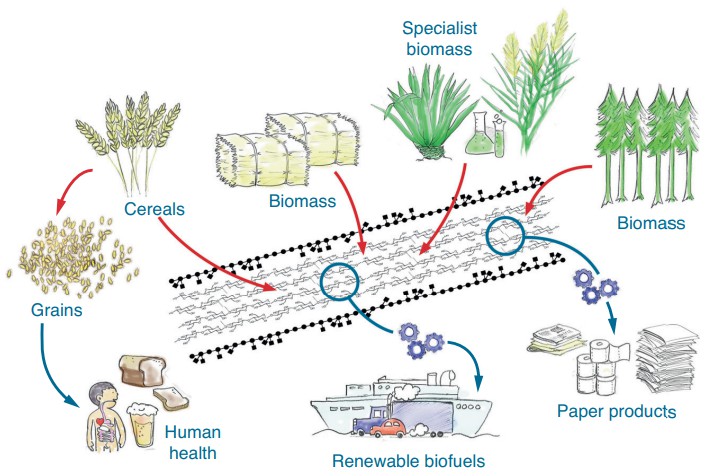Plant cell walls, composed primarily of cellulose, non-cellulosic polysaccharides, and lignin, are the largest source of renewable carbohydrates on the planet. Lifeasible is committed to providing plant cell wall engineering to produce renewable transportation fuels and other valuable products.
Due to rapid climate change, exacerbated by human activity and the use of non-renewable fossil fuels, attention is now focused on plants as a renewable source of fuel and materials. Cell walls constitute more than half of a plant's dry biomass and are a renewable, untapped resource. Concerted efforts are underway to convert wall polysaccharides from crop residues into renewable transportation fuels and other valuable products and to capitalize on the dietary benefits of grain wall polysaccharides for human health. In current commercial biorefinery processes, lignocellulosic materials are broken down at high temperatures using chemical pretreatment, and polysaccharides are converted to monosaccharides by an enzyme mixture. The sugars can then be fermented by microorganisms or reformed by chemical catalysis to produce desired chemicals or fuels. For the biorefinery process to be economically viable, many obstacles must be overcome. One such barrier includes optimizing quantitative agronomic traits by increasing the yield of lignocellulosic biomass per hectare, e.g., by selecting suitable feedstocks for specific environmental weather/growing conditions. Another obstacle includes the qualitative characteristics of the lignocellulosic biomass, e.g., by making the carbohydrates more readily available to enzymes to reduce recalcitrance to degradation or by optimizing the composition of the fermentation step.
 Fig. 1. Engineering cell walls for human health and industrial applications. (Burton, et al., 2014)
Fig. 1. Engineering cell walls for human health and industrial applications. (Burton, et al., 2014)
Lifeasible offers customizable plant cell wall engineering solutions to enhance biofuel production. Our experts use molecular and genetic techniques to optimize the composition and structure of different cell types and plant cell walls for end use. We have flexible design capabilities to maximize the recovery of biomass carbon for biofuels and the by-products needed to produce cell wall structures.
We offer several strategies to modify the qualitative composition of cell wall materials to amplify the economic value of plant cell wall engineering.
We offer several approaches to reduce lignin recalcitrance, minimize lignin waste streams, and/or add value. These approaches include genomics, transcriptomics, and synthetic biology.
We use omic techniques to discover novel enzymes and metabolites from plants or microorganisms that can subsequently be used to manipulate lignin content and composition. In addition, they help to reconstruct the regulatory networks controlling the biosynthesis of different secondary cell wall components and identify promoters with desired expression profiles that can subsequently be used to engineer plants and optimize tissue-specific expression of transgenes. With this approach, we ensure a reduction of cell wall lignin content by more than 20% without compromising plant growth.
Our experts also develop alternative approaches focused on altering lignin composition, such as controlling the monomeric composition of lignin to reduce lignin polymerization and overall biomass noncompliance. We also offer synthetic biology to isolate affected crop mutants from different collections at different lignin biosynthesis steps or generate them through silencing strategies.
Polysaccharides in lignocellulosic biomass are composed of carbohydrates and contain acetyl esters, methyl esters, and ethers, modifications that increase non-compliance. We reduce lignocellulosic acetyl content by genetically interfering with the synthesis of acetylated polysaccharides. We also work to develop mutant-engineered plants with reduced cell wall acetylation. We provide strategies to heterologously express ferulic acid esterase in plants to reduce ferulic acid in the cell wall.
We offer overexpression of sucrose synthase, manipulation of the nucleotide sugar conversion pathway, or engineering polysaccharide synthases and glycosyltransferases as strategies to increase polysaccharides with high hexose/pentose ratios to increase fermentation yields further. We aim to improve fermentation yields by increasing the abundance of fermentable sugars in lignocellulose.
Lifeasible offers multiple strategies for biomolecular engineering in plants to make biomass more suitable for biofuel production. The most important goal is engineered lignin without compromising plant growth and biomass accumulation. Contact us today to learn more about our solutions.
Reference